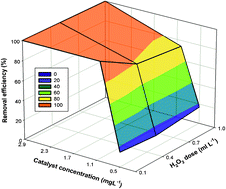Novel Claycunbic to eliminate micropollutants and Vibrio fischeri from water†
Abstract
Montmorillonite clay (K10) was used as a precursor for the synthesis of a catalytic adsorbent, Claycunbic (Bi/Cu-pillared K10), which was characterized by

* Corresponding authors
a
Pegasus Technical Services Inc, E. Hollister Street, Cincinnati, OH, USA
E-mail:
Virkutyte.Jurate@epa.gov
b
Sustainable Technology Division, National Risk Management Research Laboratory, U.S. Environmental Protection Agency, MS 443, 26 West M. L. K. Drive, Cincinnati, Ohio, USA
E-mail:
Varma.Rajender@epa.gov
Montmorillonite clay (K10) was used as a precursor for the synthesis of a catalytic adsorbent, Claycunbic (Bi/Cu-pillared K10), which was characterized by

 Please wait while we load your content...
Something went wrong. Try again?
Please wait while we load your content...
Something went wrong. Try again?
J. Virkutyte and R. S. Varma, RSC Adv., 2012, 2, 3416 DOI: 10.1039/C2RA01088G
To request permission to reproduce material from this article, please go to the Copyright Clearance Center request page.
If you are an author contributing to an RSC publication, you do not need to request permission provided correct acknowledgement is given.
If you are the author of this article, you do not need to request permission to reproduce figures and diagrams provided correct acknowledgement is given. If you want to reproduce the whole article in a third-party publication (excluding your thesis/dissertation for which permission is not required) please go to the Copyright Clearance Center request page.
Read more about how to correctly acknowledge RSC content.
 Fetching data from CrossRef.
Fetching data from CrossRef.
This may take some time to load.
Loading related content
